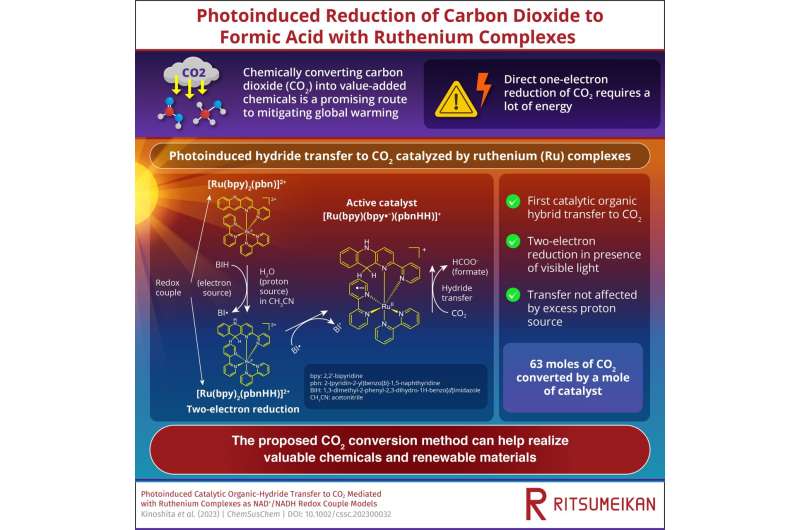This article has been reviewed according to Science X's editorial process and policies. Editors have highlighted the following attributes while ensuring the content's credibility:
fact-checked
proofread
Fighting climate change: Photoinduced reduction of carbon dioxide to formic acid with ruthenium complexes

Climate change is a global environmental concern. A major contribution to climate change comes from excessive burning of fossil fuels. They produce carbon dioxide (CO2), a greenhouse gas responsible for global warming. In this light, governments globally are framing policies to curb such carbon emissions. However, merely curbing carbon emissions may not be enough. Managing the generated carbon dioxide is also necessary.
On this front, scientists have suggested chemically converting CO2 into value-added compounds, such as methanol and formic acid (HCOOH). Producing the latter requires a source of hydride ion (H-), which is equivalent to one proton and two electrons. For instance, the nicotinamide adenine dinucleotide (NAD+/NADH) reduction-oxidation couple is a hydride (H-) generator and reservoir in biological systems.
Against this backdrop, a group of researchers led by Professor Hitoshi Tamiaki from Ritsumeikan University, Japan, have now developed a novel chemical method that reduces CO2 to HCOOH using NAD+/NADH-like ruthenium complexes. Their work was published in the journal ChemSusChem on January 13, 2023.
Prof. Tamiaki explains the motivation behind their research. "Recently, a ruthenium complex with an NAD+ model—[Ru(bpy)2(pbn)](PF6)2—was shown to undergo photochemical two-electron reduction. It produced the corresponding NADH-type complex [Ru(bpy)2(pbnHH)](PF6)2 under visible light irradiation in the presence of triethanolamine in acetonitrile (CH3CN)," he says.
"Further, the bubbling of CO2 into the [Ru(bpy)2(pbnHH)]2+ solution regenerated [Ru(bpy)2(pbn)]2+ and produced formate ion (HCOO-). However, its yield was quite low. Therefore, transferring H- to CO2 required an improved catalytic system."
Consequently, the researchers explored various reagents and reaction conditions to facilitate CO2 reduction. Based on those experiments, they proposed a photoinduced two-electron reduction of the [Ru(bpy)2(pbn)]2+/[Ru(bpy)2(pbnHH)]2+ redox couple in the presence of 1,3-dimethyl-2-phenyl-2,3-dihydro-1H-benzo[d]imidazole (BIH). Moreover, water (H2O), instead of triethanolamine, in CH3CN further improved the yield.
In addition, the researchers explored the underlying reaction mechanism using techniques like nuclear magnetic resonance, cyclic voltammetry, and UV-Vis spectrophotometry. Based on this, they proposed the following: First, the photo-excitation of [Ru(bpy)2(pbn)]2+ produces [RuIII(bpy)2(pbn•−)]2+* radical, which undergoes reduction by BIH to give [RuII(bpy)2(pbn•−)]2+ and BIH•+. Following this, H2O protonates the ruthenium complex, generating [Ru(bpy)2(pbnH•)]2+ and BI•. The obtained product undergoes disproportionation to generate [Ru(bpy)2(pbnHH)]2+ and gives back [Ru(bpy)2(pbn)]2+. Then, the former is reduced by BI• to produce [Ru(bpy)(bpy•−)(pbnHH)]+. This complex is an active catalyst and transfers H- to CO2, producing HCOO- and formic acid.
The researchers showed that the proposed reaction demonstrated a high turnover number—moles of CO2 converted by a mole of catalyst—of 63.
Excited by these findings, the researchers hope to develop a new methodology of energy conversion (sunlight to chemical energy) for the production of novel renewable materials.
"Our method would also decrease the total amount of CO2 gas on Earth and help maintain the carbon cycle. Thus, it could reduce global warming in the future," adds Prof. Tamiaki. "Further, the novel organic hydride transfer technology will provide us with invaluable chemical compounds."
More information: Yusuke Kinoshita et al, Photoinduced Catalytic Organic‐Hydride Transfer to CO 2 Mediated with Ruthenium Complexes as NAD + /NADH Redox Couple Models**, ChemSusChem (2023). DOI: 10.1002/cssc.202300032
Provided by Ritsumeikan University




















